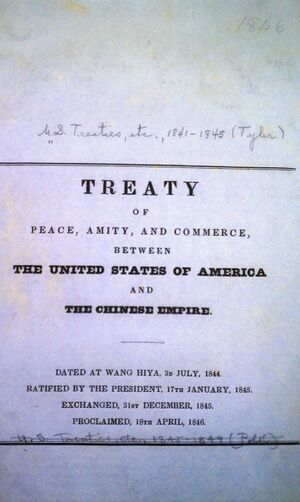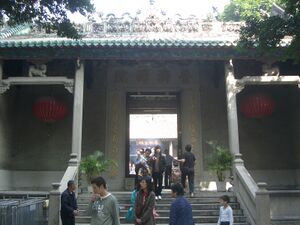معاهدة وانغهيا
| معاهدة السلام والصداقة والتجارة، بين الولايات المتحدة الأمريكية والإمبراطورية الصينية | |
|---|---|
 | |
| النوع | ثنائية / غير متكافئة |
| وُقـِّعت | 3 يوليو 1844 |
| المكان | معبد كون إيام في مكاو البرتغالية |
| الأطراف | |
| اللغات | الإنجليزية و الصينية |
| معاهدة وانغهيا | |||||||||||||
|---|---|---|---|---|---|---|---|---|---|---|---|---|---|
| الصينية التقليدية | 望廈條約 | ||||||||||||
| الصينية المبسطة | 望厦条约 | ||||||||||||
| |||||||||||||
معاهدة وانگهيا Treaty of Wanghia (وتُعرف أيضاً بإسم معاهدة وانگشيا؛ و معاهدة السلام والصداقة والتجارة، بين الولايات المتحدة الأمريكية والإمبراطورية الصينية؛[1] صينية: [中美]望廈條約 / [中美]望厦条约�) كانت أول المعاهدات غير المتكافئة التي فرضتها الولايات المتحدة على الصين. As per the terms of the diplomatic agreement, the United States received the same privileges with China that Great Britain had achieved under the Nanjing Treaty in 1842. The United States received additional privileges as well, including the right to cabotage on preferential terms and the expansion of extraterritoriality. Imperial China's Qing dynasty signed the treaty with the United States on July 3, 1844, in the Kun Iam Temple. The treaty was subsequently passed by the U.S. Congress and ratified by President John Tyler on January 17, 1845.[2] The Treaty of Wanghia was formally in effect حتى توقيع المعاهدة الأمريكية-الصينية للتخلي عن الحقوق خارج الحدود الإقليمية في الصين في 1943.
. . . . . . . . . . . . . . . . . . . . . . . . . . . . . . . . . . . . . . . . . . . . . . . . . . . . . . . . . . . . . . . . . . . . . . . . . . . . . . . . . . . . . . . . . . . . . . . . . . . . . . . . . . . . . . . . . . . . . . . . . . . . . . . . . . . . . . . . . . . . . . . . . . . . . . . . . . . . . . . . . . . . . . . .
اسم المعاهدة
The treaty was named after a village in northern Macau where the temple is located, called Mong Ha or Wang Hia (الصينية التقليدية: 望廈؛ الصينية المبسطة: 望厦؛ پنين: Wàngxià؛ كانتونية يل: Mohng Hah�).[3] It is now a part of the territory's Our Lady of Fátima Parish.
مضمون المعاهدة
The United States was represented by Caleb Cushing, a Massachusetts lawyer dispatched by President John Tyler under pressure from American merchants concerned about British dominance in trade with China.[3] Physician and missionary Peter Parker served as Cushing's Chinese interpreter. The Qing Empire was represented by Keying, the Viceroy of Liangguang, who held responsibility for the provinces of Guangdong and Guangxi.[4][5])
The treaty was modeled after the treaties of Nanking and the Bogue between the United Kingdom and China, but differed in being more detailed.[3] Among other things, it contained provisions for:
- Extraterritoriality, where Chinese subjects would be tried and punished under Chinese law and American citizens would be tried and punished under the authority of the American consul or other public functionaries authorized to that effect[3]
- Fixed tariffs on trade in the treaty ports
- The right to buy land in the five treaty ports and erect churches and hospitals there
- The right to learn Chinese by abolishing a law which thitherto forbade foreigners to do so[6]
- The U.S. received most favored nation status, resulting in the United States receiving the same beneficial treatment China gave to other Western powers, and received the right to modify the treaty after 12 years.
The United States also granted the Chinese Empire powers to confiscate American ships if operating outside treaty ports, and withdrew consular protection in cases where American citizens were trading in opium under articles 3 and 33, respectively.[3] Furthermore, the U.S. agreed to hand over any offenders to China. (Americans entered the opium trade with less expensive but inferior Turkish opium and by 1810 had around 10% of the trade in Canton.[7])
متفرقات

انظر أيضاً
الهامش
- ^ http://lccn.loc.gov/12033773 Treaty of peace, amity, and commerce, between the United States of America ..., Library of Congress
- ^ [1] Library of Congress, Treaty of peace, amity, and commerce, between the United States of America ...
- ^ أ ب ت ث ج Cassel, Pär (2012). Grounds of Judgment. New York: Oxford University Press. p. 53. ISBN 978-0-19-979205-4.
- ^ Koon, Yeewan (2012). "The Face of Diplomacy in 19th-Century China: Qiying's Portrait Gifts". In Johnson, Kendall (ed.). Narratives of Free Trade: The Commercial Cultures of Early US-China Relations. Hong Kong University Press. pp. 131–148.
- ^ Tyler Dennett, Americans in Eastern Asia: A critical study of the policy of the United States with reference to China, Japan and Korea in the 19th century (Macmillan, 1922) pp 145-171. online.
- ^ Article 18 of the treaty states, "It shall be lawful for the officers or citizens of the United States to employ scholars and peoples of any part of China…to teach any of the languages of the Empire, and to assist in literary labors ... it shall in like manner be lawful for citizens of the United States to purchase all manner of books in China."
- ^ Tyler Dennett, Americans in Eastern Asia pp 115-124.
المراجع
- Dennett, Tyler. Americans in eastern Asia; a critical study of the policy of the United States with reference to China, Japan and Korea in the 19th century (1922) online
- Downs, Jacques M., and Frederic D. Grant Jr. The Golden Ghetto: the American commercial community at canton and the shaping of American China Policy, 1784–1844 (Hong Kong University Press, 2014) online.
- Henson, Jr., Curtis T. Commissioners and Commodores: The East Indian Squadron and American Diplomacy in China (U of Alabama Press, 1982)
- Kuo, Ping Chia. "Caleb Cushing and the Treaty of Wanghia, 1844". The Journal of Modern History 5, no. 1 (1933): 34–54. online
- Le Pichon, Alain. "Howqua And the Howqua: how a Chinese monopolist saved American free-traders from financial ruin." Journal of the Royal Asiatic Society Hong Kong Branch 50 (2010): 99–121. online
- Swisher, Earl, ed. China's Management of the American Barbarians; a Study of Sino-American Relations, 1841–1861, with Documents. New Haven, CT: Published for the Far Eastern Association by Far Eastern Publications, Yale University, 1953.
- Welch, Richard E. "Caleb Cushing's Chinese Mission and the Treaty of Wanghia: A Review." Oregon Historical Quarterly 58.4 (1957): 328–357. online



